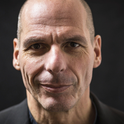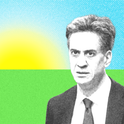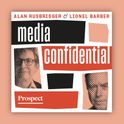A man sits with his arms folded across his legs, his head bowed against his knees. Another lies flat like a starfish face down on the floor. A third sits with his hand to his ear, listening for something. They are all Antony Gormley. Or rather, they are all metal figures moulded from Antony Gormley’s body.
“This is all very old. The work upstairs began in 1977, the most recent work in here is from 1993, so it’s all 30 years or more old,” Gormley tells me. We’re at the preview of his new exhibition “WITNESS: Early Lead Works” on show at the White Cube in central London. I’ve managed to catch him in between queues of people vying for his attention, including Chris Bryant, minister for creative industries.
Gormley is calm and collected as he deals with the steady stream of fans, friends and “important people”. He apologises to me the first time I try to engage with him because he has to speak to the latter. When we do get to speaking, the first thing I notice are his piercing blue eyes. He is wearing slim, round spectacles and a white shirt, nothing to give away that he has become the nation’s best-known sculptor. His works punctuate landscapes up and down the country—most famously Angel of the North (1998) in Gateshead, near Newcastle. More recently, Another Time (2017) was installed on Fulsam Rock in Margate, Kent—home of famous creatives including artist Tracey Emin and actor Emma Corrin.
In the years that Gormley made his early sculptures displayed at the exhibition, he says, he was preoccupied by the Cold War and the possibility of nuclear Armageddon. But today, the works articulate his concern over the most urgent threat to humanity in modern times—climate change. “It’s a creeping realisation that our way of living is toxic to the biosphere,” he says.
Perhaps it’s no coincidence that the gallery preview falls the day after Earth Day, I suggest. “It’s a very necessary synchronism,” Gormley responds. “Now we are living in a time of rising rearmament, rising nationalism, all forms of media manipulation and identity politics that is making the world a highly dangerous place—and distracting us from the climate emergency.” For Gormley, it seems, there is nothing else worth discussing.
I ask about the state of the arts in the UK and how he feels about the Royal Academy’s plummeting visitor figures and resulting redundancies. He has been a Royal Academician since 2003, and his solo exhibition took over the main galleries there in 2019. “I don’t want to talk about that,” he cuts me off hastily.
What about AI? “AI is a wonderful resource, but the one thing it’s not going to replace is human creativity,” he says. “Even though they keep coming up with rather sad versions of so-called AI independent machine-learnt creativity.” Gormley then sends me to Bryant to speak more about that.
“I was in Cambridge at a video games company, and they use AI, and they say we wouldn’t be able to survive without it,” the minister tells me. “Musicians use AI all the time.” Musicians also happen to be the community most outraged by the changes being made to UK copyright law going through parliament. They fear the new law will allow AI companies to train models on copyrighted music without permission or fair compensation.
Gormley himself is critical of the current government. “They’re manic about growth and it’s very obvious that growth is the one thing we don’t need,” he tells me. “We’ve got to learn to live with enough. Not always with more. And we’ve got to learn how to distribute what we have in a more equitable way.” Not that Gormley has ever had to learn such a lesson. He was born and raised in Hampstead, north London, in a home overlooking the local golf course with a cook and a chauffeur. Now, he lives between his 18th-century estate in Norfolk and his studio in King’s Cross, central London.
So, what advice does the artist have for chancellor Rachel Reeves? “The thing that she should be thinking about is how she uses the soft power of art more effectively,” he says. “It’s only through the generation of new art that we will find alternatives to business as usual. If we carry on with business as usual, we’re not going to have a world.”












